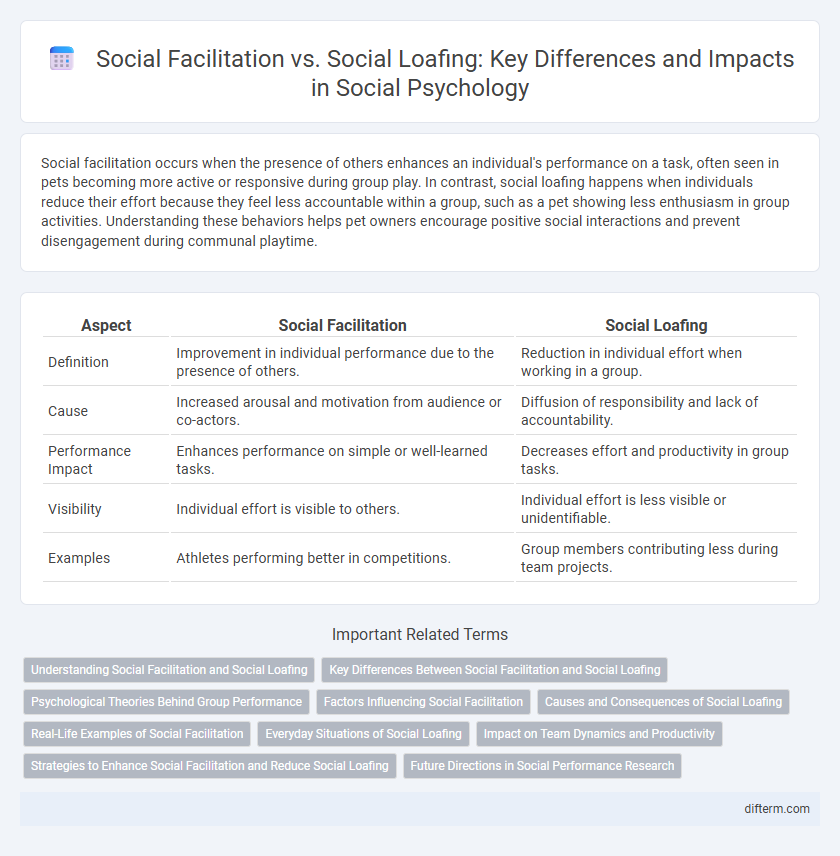Social facilitation occurs when the presence of others enhances an individual's performance on a task, often seen in pets becoming more active or responsive during group play. In contrast, social loafing happens when individuals reduce their effort because they feel less accountable within a group, such as a pet showing less enthusiasm in group activities. Understanding these behaviors helps pet owners encourage positive social interactions and prevent disengagement during communal playtime.
Table of Comparison
| Aspect | Social Facilitation | Social Loafing |
|---|---|---|
| Definition | Improvement in individual performance due to the presence of others. | Reduction in individual effort when working in a group. |
| Cause | Increased arousal and motivation from audience or co-actors. | Diffusion of responsibility and lack of accountability. |
| Performance Impact | Enhances performance on simple or well-learned tasks. | Decreases effort and productivity in group tasks. |
| Visibility | Individual effort is visible to others. | Individual effort is less visible or unidentifiable. |
| Examples | Athletes performing better in competitions. | Group members contributing less during team projects. |
Understanding Social Facilitation and Social Loafing
Social facilitation refers to improved individual performance in the presence of others, driven by increased arousal and motivation, especially on well-practiced tasks. In contrast, social loafing occurs when individuals exert less effort in group settings, often due to reduced accountability and diffusion of responsibility. Understanding these phenomena reveals how social dynamics influence productivity and group behavior in various contexts.
Key Differences Between Social Facilitation and Social Loafing
Social facilitation enhances individual performance in the presence of others, especially on well-practiced tasks, while social loafing results in decreased effort when individuals work in groups. Social facilitation is driven by increased arousal and motivation, whereas social loafing occurs due to reduced accountability and diffusion of responsibility. Understanding these contrasting effects is crucial for optimizing group dynamics and improving collaborative productivity.
Psychological Theories Behind Group Performance
Social facilitation theory explains how the presence of others enhances an individual's performance on simple or well-practiced tasks through increased arousal and motivation. Conversely, social loafing occurs when individuals exert less effort in a group due to diffusion of responsibility and decreased accountability. Psychological models such as Zajonc's drive theory and the Ringelmann effect provide empirical support for these contrasting group performance phenomena.
Factors Influencing Social Facilitation
Factors influencing social facilitation include the presence of an audience, task complexity, and individual arousal levels. Simple or well-practiced tasks often see improved performance due to heightened arousal, while complex or new tasks may deteriorate under pressure. The evaluation apprehension caused by others' observation and the individual's level of expertise also significantly impact social facilitation effects.
Causes and Consequences of Social Loafing
Social loafing occurs when individuals exert less effort in a group task due to reduced accountability, diffusion of responsibility, or lack of motivation linked to perceived dispensability. Causes include unclear individual roles, absence of performance evaluation, and weak group cohesion, leading to diminished group productivity and lower overall task performance. Consequences often manifest as decreased motivation, increased social disengagement, and impaired group dynamics, ultimately undermining collaboration and achievement of collective goals.
Real-Life Examples of Social Facilitation
Individual performance often improves in the presence of others, as seen when athletes excel during competitions due to heightened arousal and motivation, demonstrating social facilitation. Public speaking engagements also reveal this effect, where speakers deliver more energetic and confident presentations under audience observation. Workplace scenarios show social facilitation when employees complete tasks more efficiently during group work or team meetings compared to working alone.
Everyday Situations of Social Loafing
In everyday situations, social loafing often occurs during group projects or team sports where individual efforts become less noticeable, leading some members to contribute minimally. This phenomenon reduces overall productivity and motivation, as individuals rely on others to carry the workload. Recognizing and addressing social loafing by assigning clear roles and accountability can enhance group performance and collaboration.
Impact on Team Dynamics and Productivity
Social facilitation enhances team dynamics by increasing individual effort and performance in the presence of others, often boosting productivity during straightforward tasks. Conversely, social loafing decreases group efficiency as some members exert less effort, relying on teammates to carry the workload, which undermines collective output. Understanding the balance between these phenomena is crucial for optimizing collaboration and achieving organizational goals.
Strategies to Enhance Social Facilitation and Reduce Social Loafing
Enhancing social facilitation involves designing tasks that are challenging yet attainable and providing positive feedback to boost motivation and focus. To reduce social loafing, implementing clear individual accountability and assigning specific roles within groups ensures members contribute equitably. Encouraging group cohesion and setting measurable performance goals optimize collective effort and elevate overall productivity in social contexts.
Future Directions in Social Performance Research
Future research in social performance should explore the neural mechanisms differentiating social facilitation from social loafing to better understand individual variability. Advanced neuroimaging combined with ecological momentary assessment can provide real-time data on how social contexts influence performance levels. Investigating the impact of virtual environments on these phenomena will also inform strategies for optimizing collaborative work in remote and hybrid settings.
social facilitation vs social loafing Infographic

 difterm.com
difterm.com